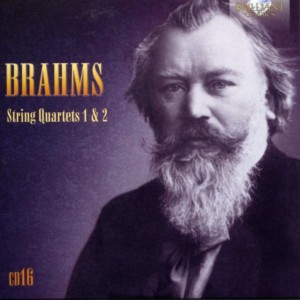 I expect big things from today’s CD.
I expect big things from today’s CD.
String quartets are usually where a composer can shine.
Some of my favorite music is a string quartet.
So my ears are wide open this morning, watching the thunderstorm roll through, sipping a hot cup of coffee. Ear buds in.
I have all the time I need to listen to Brahms.
Which is what I am doing.
However, so far, I’m not impressed.
Here’s what’s on Brahms CD 16:
String Quartet No. 1 in C minor Op. 51 No. 1
String Quartet No. 2 in A minor Op. 51 No. 2
From their entry on Wikipedia:
Johannes Brahms’s String Quartets Nos. 1 in C minor and 2 in A minor were completed in Tutzing, Bavaria, during the summer of 1873, and published together that autumn as Opus 51. They are dedicated to his friend Theodor Billroth.
Brahms was slow in writing his first two string quartets. We know from a letter from Joseph Joachim that a C-minor quartet was in progress in 1865, but it may not have been the same work that would become Opus 51 No. 1 in 1873. Four years before publication, however, in 1869, we know for certain that the two quartets were complete enough to be played through. But the composer remained unsatisfied. Years passed. New practice runs then occurred in Munich, probably in June 1873, and Brahms ventured south of the city to the small lakeside town of Tutzing for a summer respite. There, with the Würmsee (as Lake Starnberg was then called) and the Bavarian Prealps as backdrop, he put the finishing touches on the two quartets.
He was 40 years old at the time of publication. Brahms regarded the string quartet as a particularly important genre. He reportedly destroyed some twenty string quartets before allowing the two Op. 51 quartets to be published.[1] At least one of the quartets (No. 1 in C minor) had been complete as early as 1865 but Brahms continued to revise it for nearly a decade.
Performers are:
Tokyo Quartet
Peter Oundjian, Kikuei Ideka violins
Kazuhide Isomura viola
Sadao Harada cello
The music is played with deftness, precision, and confidence.
But it’s just not moving me.
What I’m not necessarily hearing in this music is the sound of ice cubes tinkling against the sides of glasses, indulgent laughter from men and women trying to impress one another, and a murmur of a crowd oohing and ahhing over art they have no hope of understanding, explaining, or even liking.
In other words, one of the things a string quartet reminds me of is the music played during a wine-and-cheese soiree at an art gallery.
This doesn’t sound like that. It’s not Baroque-y enough or something.
It just sounds like great musicians playing average music, lots of music written in the same tempo – with the one possible exception being Movement IV (“Allegro non assai”) from String Quartet No. 2 in A minor Op. 51 No. 2. I thought I heard a little life in that composition. But I wasn’t sure.
Am I too hard on Brahms?
Maybe Brahms following Beethoven wasn’t such a good idea.
Maybe if I scheduled Brahms after Haydn this would sound like something Olympian gods handed down to mere mortals.
Alas…
